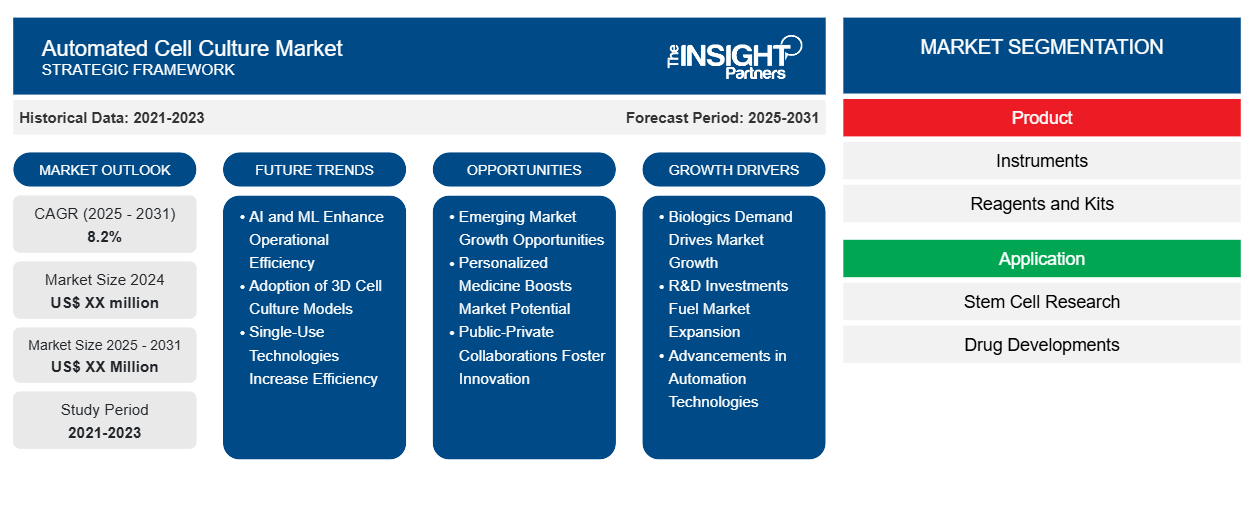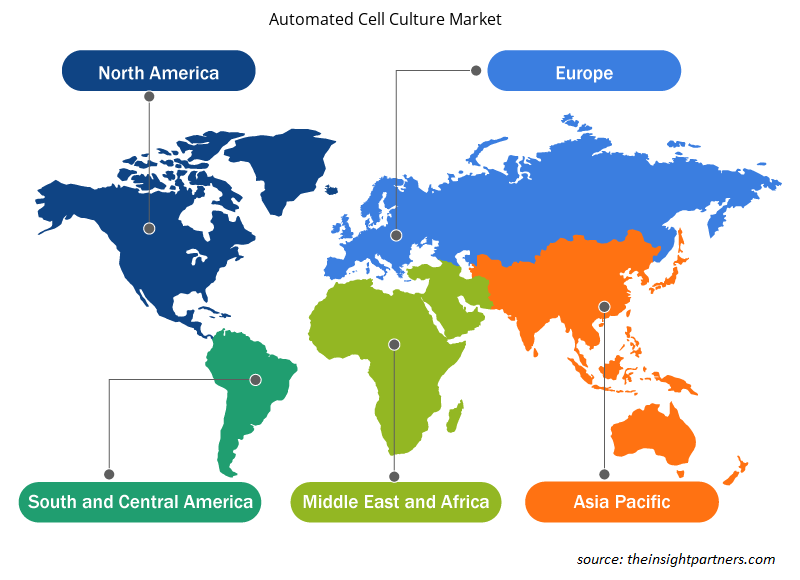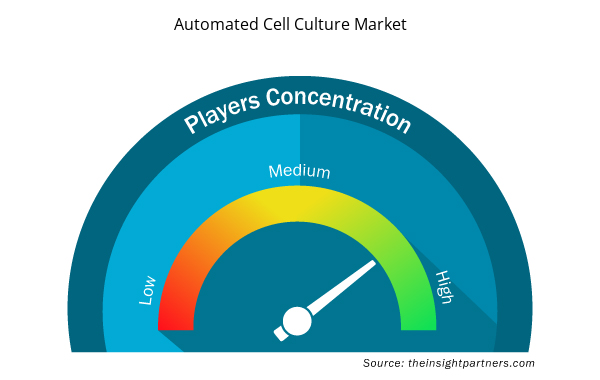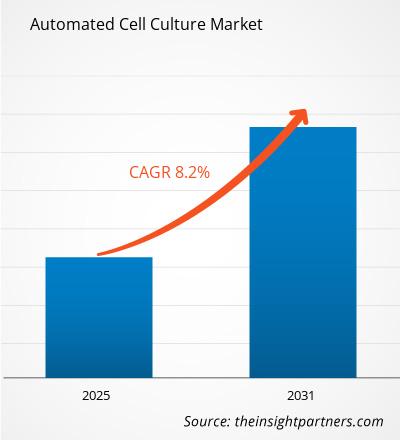The Automated Cell Culture Market is expected to register a CAGR of 8.2% from 2025 to 2031, with a market size expanding from US$ XX million in 2024 to US$ XX Million by 2031.
The Automated Cell Culture Market report covers analysis By Product, Application, and End User. The global analysis is further broken-down at regional level and major countries. The Report Offers the Value in USD for the above analysis and segments.
Purpose of the Report
The report Automated Cell Culture Market by The Insight Partners aims to describe the present landscape and future growth, top driving factors, challenges, and opportunities. This will provide insights to various business stakeholders, such as:
- Technology Providers/Manufacturers: To understand the evolving market dynamics and know the potential growth opportunities, enabling them to make informed strategic decisions.
- Investors: To conduct a comprehensive trend analysis regarding the market growth rate, market financial projections, and opportunities that exist across the value chain.
- Regulatory bodies: To regulate policies and police activities in the market with the aim of minimizing abuse, preserving investor trust and confidence, and upholding the integrity and stability of the market.
Automated Cell Culture Market Segmentation
Product
- Instruments
- Reagents and Kits
Application
- Stem Cell Research
- Drug Developments
End User
- Pharmaceutical and Biotechnology Companies
- Academic Institutes
- Research Organizations
Geography
- North America
- Europe
- Asia-Pacific
- South and Central America
- Middle East and Africa
Customize This Report To Suit Your Requirement
You will get customization on any report - free of charge - including parts of this report, or country-level analysis, Excel Data pack, as well as avail great offers and discounts for start-ups & universities
Automated Cell Culture Market: Strategic Insights

- Get Top Key Market Trends of this report.This FREE sample will include data analysis, ranging from market trends to estimates and forecasts.
Automated Cell Culture Market Growth Drivers
- Biologics Demand Drives Market Growth: The increasing demand for biologics, including vaccines, antibodies, and cell therapies, is a key driver in the automated cell culture and a critical resource for the global healthcare sector. Efficient, scalable production processes increase Automated Cell Culture Market size and market share. Automated systems enhance consistency, minimize manual errors, and simplify cell culture workflows, as per market analysis reports. Such advancements support market growth that is widely adopted by pharmaceutical and biotechnology companies.
- R&D Investments Fuel Market Expansion: Growth of investments in R&D, especially drug discovery, stem cell research, and personalized medicine, is driving the automated cell culture market. Automated Cell Culture Market trends focus on a high push for automated solutions, given that high-throughput and reproducible processes will be the future demand. The increasing funding from governments, research institutions, and industry leaders is further enhancing Automated Cell Culture Market growth and seizing large market shares, according to Automated Cell Culture Market overview reports where this dynamic growth driver can be seen.
- Advancements in Automation Technologies: Advancements in cell culture automation technologies, such as robotics, artificial intelligence, and advanced imaging, are changing the scenario. These advancements increase market size due to their ability to provide accurate, scalable solutions and reduce operational costs while building productivity. Market analysis concludes companies have been taking up these technologies to make workflows more efficient as well as deal with the increasing demand for complex cell-based therapies, which has further led to increased growth in the market. Increasingly, market reports have shed light on the rising trend of automation as a key driving force in the industry.
Automated Cell Culture Market Future Trends
- AI and ML Enhance Operational Efficiency: AI and ML integration has become a strong trend in the automated cell culture market to optimize data analysis, predictive modeling, and market dynamics. The SWOT analysis reflects the potential for them to boost operational efficiency. Such technologies are employed by key players to devise market strategies more precisely. The market has also indicated that this is the change of phase that brings more intelligent systems and efficient usage of resources. The positive PEST analysis related to technology has encouraged such an attitude.
- Adoption of 3D Cell Culture Models: Adoption of 3D cell culture models: There is an emerging trend in the automation of cell culture with the adoption of 3D cell culture models that are tagged as notable for their ability to closely approximate the in vivo environment. These are gradually being demanded in drug discovery and disease modeling. Market leaders are finding ways to exploit this through novel market strategies that build up the dynamics of this market along with improved research results. Market prediction and PEST analysis depict a trend of increase in demand for complex accurate biological models that will foster growth.
- Single-Use Technologies Increase Efficiency: Greater flexibility, low contamination, and lower cost make the single-use technologies highly used in the automated cell culture. These systems have gained momentum towards Automated Cell Culture Market strategies, focusing on efficiency and adaptability - key factors to key players' interest in the biopharmaceutical sector. Overall market dynamics have revealed impressive growth with application in scalable cell cultures. SWOT analysis reflects some environmental challenges but is otherwise positive about Automated Cell Culture Market analysis and includes all segments of market adoption, mainly driven by the demand of users.
Automated Cell Culture Market Opportunities
- Emerging Market Growth Opportunities: Growth opportunities are reaped in emerging markets, mainly in Asia-Pacific and Latin America. These regions represent higher levels of healthcare spending, research activity, and government support for biopharmaceuticals. Competitive analysis has identified market strategies suited to local conditions, thereby enhancing the market footprint and share of companies. Geography-specific opportunities have brought about positive market momentum as regional industry trends reveal a rise in demand for new cell culture technologies and automation.
- Personalized Medicine Boosts Market Potential: Personalized medicine is an emerging opportunity for the automated cell culture market. With a shifting landscape toward patient-specific treatments, automation is a vital enabler of scalable and high-precision cell culture processes.
- Public-Private Collaborations Foster Innovation: Increased collaboration between public institutions, private companies, and governments opens up valuable growth opportunities for the automated cell culture market. Such partnerships encourage innovation, sponsor R&D projects, and enhance industry landscapes, especially in advanced and emerging economies. Competitive analysis shows that the joint efforts benefit the key players in setting up standards, enhancing production capabilities, and expanding geographical reach. Market dynamics show government-backed initiatives in accelerating the adoption of technology and, therefore, creating long-term opportunities for Automated Cell Culture Market expansion.
Automated Cell Culture Market Regional Insights
The regional trends and factors influencing the Automated Cell Culture Market throughout the forecast period have been thoroughly explained by the analysts at Insight Partners. This section also discusses Automated Cell Culture Market segments and geography across North America, Europe, Asia Pacific, Middle East and Africa, and South and Central America.

- Get the Regional Specific Data for Automated Cell Culture Market
Automated Cell Culture Market Report Scope
| Report Attribute | Details |
|---|---|
| Market size in 2024 | US$ XX million |
| Market Size by 2031 | US$ XX Million |
| Global CAGR (2025 - 2031) | 8.2% |
| Historical Data | 2021-2023 |
| Forecast period | 2025-2031 |
| Segments Covered |
By Product
|
| Regions and Countries Covered | North America
|
| Market leaders and key company profiles |
Automated Cell Culture Market Players Density: Understanding Its Impact on Business Dynamics
The Automated Cell Culture Market market is growing rapidly, driven by increasing end-user demand due to factors such as evolving consumer preferences, technological advancements, and greater awareness of the product's benefits. As demand rises, businesses are expanding their offerings, innovating to meet consumer needs, and capitalizing on emerging trends, which further fuels market growth.
Market players density refers to the distribution of firms or companies operating within a particular market or industry. It indicates how many competitors (market players) are present in a given market space relative to its size or total market value.
Major Companies operating in the Automated Cell Culture Market are:
- Sartorius
- Merck KGaA
- Eppendorf AG
- BD
- Thermo Fisher Scientific Inc.
Disclaimer: The companies listed above are not ranked in any particular order.

- Get the Automated Cell Culture Market top key players overview
Key Selling Points
- Comprehensive Coverage: The report comprehensively covers the analysis of products, services, types, and end users of the Automated Cell Culture Market, providing a holistic landscape.
- Expert Analysis: The report is compiled based on the in-depth understanding of industry experts and analysts.
- Up-to-date Information: The report assures business relevance due to its coverage of recent information and data trends.
- Customization Options: This report can be customized to cater to specific client requirements and suit the business strategies aptly.
The research report on the Automated Cell Culture Market can, therefore, help spearhead the trail of decoding and understanding the industry scenario and growth prospects. Although there can be a few valid concerns, the overall benefits of this report tend to outweigh the disadvantages.
- Historical Analysis (2 Years), Base Year, Forecast (7 Years) with CAGR
- PEST and SWOT Analysis
- Market Size Value / Volume - Global, Regional, Country
- Industry and Competitive Landscape
- Excel Dataset



Report Coverage
Revenue forecast, Company Analysis, Industry landscape, Growth factors, and Trends

Segment Covered
This text is related
to segments covered.

Regional Scope
North America, Europe, Asia Pacific, Middle East & Africa, South & Central America

Country Scope
This text is related
to country scope.
Frequently Asked Questions
The report can be delivered in PDF/PPT format; we can also share excel dataset based on the request.
Some of the customization options available based on request are additional 3-5 company profiles and country-specific analysis of 3-5 countries of your choice. Customizations are to be requested/discussed before making final order confirmation, as our team would review the same and check the feasibility.
Key companies of this market are - Sartorius, Merck KGaA, Eppendorf AG, BD, Thermo Fisher Scientific Inc, Octane Biotech Inc, Cell Culture Company LLC, Hamilton Company, Tecan Trading AG.
Key future trends in this market are - Integration of AI and Machine Learning, Adoption of 3D Cell Cultures, and Focus on Single-Use Technologies
The Automated Cell Culture Market is estimated to witness a CAGR of 8.2% from 2023 to 2031.
The major factors driving the Automated Cell Culture Market are: Increasing Demand for Biologics and Regenerative Medicines, Rising Investments in Research and Development, and Technological Advancements in Cell Culture Systems
Trends and growth analysis reports related to Life Sciences : READ MORE..
1. Sartorius
2. Merck KGaA
3. Eppendorf AG
4. BD
5. Thermo Fisher Scientific Inc.
6. Octane Biotech Inc.
7. Cell Culture Company, LLC
8. Hamilton Company
9. Tecan Trading AG
10. Lonza

 Get Free Sample For
Get Free Sample For